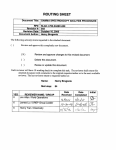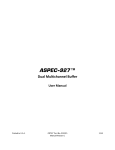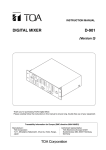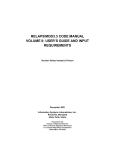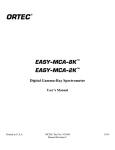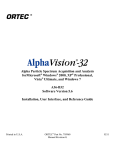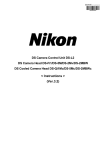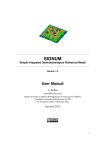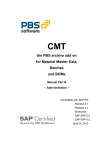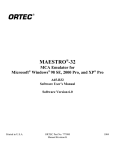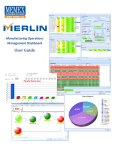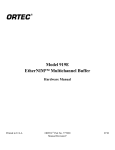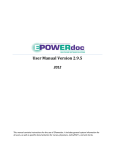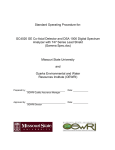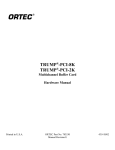Download GammaVision
Transcript
ORTEC ® ® GammaVision V6.09 Gamma Spectrum Analysis Software • • • • • • • • • • • • Comprehensive Gamma Spectrum Analysis for HPGe detector spectra. Integrated control of spectroscopy hardware. “Highly Automated” and “Highly Interactive” modes of operation. Identification and quantification of nuclide activities by adaptable methods. Wide array of spectral correction tools. Extensive use of Wizards to simplify setup and calibration. Flexible reporting to meet local requirements. Results database to facilitate LIMS integration. Comprehensive QA features. Methods compliant with latest international standards. Multi-Language support. Support for Microsoft Windows XP and Windows 7. ORTEC GammaVision Gamma Spectrum Analysis Software is a comprehensive, all-in-one package, for the analysis of gamma-ray spectra acquired with HPGe detectors. It represents over 25 years of evolutionary development by ORTEC scientists. Hardware control, advanced MCA display, and a suite of data analysis algorithms are integrated into one complete package. GammaVision is broadly applicable to gamma spectroscopy applications. A high degree of sample automation is possible for busy counting rooms and an array of corrections is provided to deal with sample, nuclide and spectrum-related effects. The methods employed are compliant with recognized national and international standards such as ANSI/ISO/ASQ 9001:2000, ASME/NQA-1-1989, and ASME/NQA-2a-1990 and ISO/DIS 11929. In addition to automation, interactive analysis tools aid the expert spectroscopist. ® GammaVision V6.09 Gamma Spectrum Analysis Software Main Graphical User Interface • Intuitive “Smart” MCA features with live display of acquiring data. • Simultaneous display of up to a total of 16 interactive windows on a single PC. • Complete control of all MCA hardware and analysis processes. • Total sample automation with simple to implement procedures. • CONNECTIONS network support provides remote control of up to 250 detectors on a single system. • Extensive password control ensures security of acquiring data and system settings. The main GammaVision graphical user interface provides a color spectral display, control of the hardware and of the analysis. The graphical spectrum display and manipulation has a common look and feel with other ORTEC spectroscopy products, particularly with the MAESTRO “smart” MCA emulator. Features such the ability to compare an acquiring spectrum with a reference from disk, or the instant live Peak Info, and Peak ID functions provide the user immediate reassurance that all is well during acquisition of a long count without having to interrupt the count itself. Functions such as Jump to next spectrum peak, library peak, or region of interest peak, while acquiring live data add to the user convenience of this MCA emulator. Instant isotope markers can mark all gamma rays of a single nuclide (from the library) when any one of the gamma ray peaks from that nuclide is selected in the spectrum. A peak amplitude estimator provides instant visual confirmation that all peaks of a nuclide are present and consistent. Review Live and Saved Spectra. In the interest of operator simplicity, the design approach is very much “what you see is what you get.” In other words, the spectrum which is started, cleared, and analyzed is the one which the operator has selected for viewing. As a member of the ORTEC CONNECTIONS suite of software products, GammaVision has the capability to fully support up to 250 detector systems across a local area network. A remote detector appearing to a local operator displays no View Isotope Markers with Peak Amplitude Estimator Bars. different than a detector physically attached to the local PC workstation. Up to eight detectors may be selected for live display on a single workstation from a system maximum of 250. Selection is made from a detector “pick list.” Multiple workstations may simultaneously display the same live detector(s) or two adjacent workstations may display different selections through unique pick lists. Each detector may be “locked” to prevent unauthorized access. GammaVision Approach to Quantitative Analysis GammaVision provides a comprehensive array of “tools” to satisfy analysis requirements, regulatory issues and spectral artifacts. These tools generally can be enabled through “set and forget choices” ensuring that sophisticated analyses may be performed by technicians in a production laboratory environment, while an interactive reanalysis mode allows an expert to verify and validate analysis quality or deal with the unexpected. A comprehensive suite of quality assurance tools ensures that Good Laboratory Practice (GLP) is achieved. 2 ® GammaVision V6.09 Gamma Spectrum Analysis Software A choice of five different analysis approaches (described below) is provided to deal with different spectral conditions and to ensure compliance in different regulatory environments. Regulatory compliance also requires that different formalisms for the determination of detection limit (MDA) may be required. GammaVision now provides a “set and forget” choice of no fewer than twelve MDA methods. (See specifications.) At its simplest, the analysis of a gamma ray spectrum involves the following distinct steps: • Peak location in a spectrum of known energy calibration. • Peak Net count rate determination. • Activity calculation, based on identification of nuclide and known efficiency calibration. GammaVision Peak Location Methods The following peak location methods are employed in GammaVision. Library Directed Peak Location This method is used wherever possible because it is the most sensitive to small peaks. Starting from the library list, the spectrum is examined for the presence of peak centroids which statistically qualify for further scrutiny. Ultimately, the determination of a nuclide activity depends on the association of library nuclide data with the area of an actual spectrum peak. Starting with a library of nuclides of interest is the most practical way of achieving this. Second Difference Peak Search This method often referred to as “Mariscotti” peak search is used to locate additional peaks in the spectrum which are not associated with library entries. These are “unidentified” peaks. They may be used for two purposes: first they can be used to alert the spectroscopist to the fact that nuclides may be missing from the analysis library which should be included and reported. The second reason is that these peaks may be close enough to library peaks in the spectrum and may require deconvolution with those peaks for accurate results. User Defined ROI Peak Location This method aids analysis of badly shaped peaks which might be rejected by the other methods as being unphysical or too poor in shape for further analysis. Where the spectroscopist “knows” that such peaks will be present and must be analyzed, this peak location method can “force” the process. (The peak centroid is defined as the ROI center.) GammaVision Analysis Methods As mentioned above, GammaVision provides five distinct analysis methods. These five methods are as follows: WAN32 is the “general purpose” analysis method, for use when none of the other four following methods is specifically mandated. The library is used to direct the determination of peak areas in the spectrum for further analysis. A subsidiary second difference peak search is used to provide possible deconvolution “candidates” which might interfere with other spectra peaks associated with library entries, but also to provide a list of found, not identified, and possibly suspect peaks in the spectrum. Minimum detectable activities may be reported if required on both identified and unidentified library nuclides. GAM32 method is similar to WAN32, with an extra “prefiltering” step. Its purpose is to allow reliable and rapid analysis of samples of completely unpredicted isotopic composition through use of a very large initial library of candidates. This is achieved by an initial second difference peak search of the spectrum itself, to create a peak list which is then used to substantially reduce the initially large library to a much smaller size to perform a WAN1 analysis. This method is specifically suited to systems which may encounter a wide variety of samples, especially in “real-time.” It was developed originally for automatic, moving paper, air particulate monitors. NPP32 is designed specifically to analyze the complex fission product spectra encountered in Nuclear Power Applications. A WAN32 type analysis is augmented with the addition of a comprehensive nuclide peak identification matrix in order to accurately determine quantitative results from these complex spectra, with the minimum of false positive identifications. Easily Select Analysis Options. 3 ® GammaVision V6.09 Gamma Spectrum Analysis Software ENV32 is a similar approach to GAM32. It starts with a second difference peak search, removing nuclides from further analysis which, although present in the user library, may be rejected because their complete expected complement of peaks have not been judged as found. A WAN1 type analysis then proceeds. An additional industry compliant feature of this analysis method is, that if after all calculations are complete, and the activity of a nuclide is calculated as negative, this result is preserved rather than discarded. (This process is referred to as “directed fit.”) MDA values are reported for every nuclide in the analysis library. This method is designed specifically for the needs of environmental-level counting laboratories. ROI32 uses the ROI peak locate method described in an otherwise unchanged WAN32 analysis for samples with known (or expected) but distorted peaks. Further guidance on the appropriate choice of analysis method is provided in the comprehensive user manual. GammaVision Corrections Beyond the simplified analyses described above, GammaVision provides correction capabilities for data and results in order to deal with: • High Count rate (random coincidence) summing. • Gain shift correction. • True Coincidence summing (geometry dependent). • Absorption of gamma rays in sample matrix of external absorber. (ANSI N42.14 and ASTM E181–82 compliant.) • Sample geometry different to calibration standard. • Sample half-life. • Short sample half-life, activity decays during acquisition. • Loss-free counting (where supported by hardware). • Nuclides in sample also in background. • Peak Interference Correction (deconvolution), or Total Overlap Correction (library based stripping). GammaVision Tools Create Attenuation and Absorber Correction Factors. The Calibration Wizard Tool Calibration or recalibration of a Gamma Spectroscopy system can prove a time consuming and troublesome process. The GammaVision Calibration Wizard makes the process simple. With a highly graphical interface, the spectroscopist can see that the calibration fits are good. The use of a source certificate file editor allows standard data to be entered once, saved and referenced for future use. The patented energy calibration method (U.S. Patent No. 6,006,162) requires only that the appropriate library is chosen for the standard being used, and with a click of the mouse, an energy calibration is performed. The spectroscopist can review the results prior to saving the calibration. Efficiency calibrations are similarly streamlined. GammaVision also provides for manual entry of calibration data, which may be useful in certain circumstances; for example, when only a “less than ideal” calibration standard is available. An example might be having to calibrate on an old standard in which some of the nuclides are missing, having decayed to a very low level. Analysis Library Manager Tool Quickly Create and Review Calibrations. The GammaVision library manager makes library building and editing both intuitive and easy. Nuclides may be easily transferred from a larger master library or from multiple master libraries using simple cut and paste operations. In addition, GammaVision also includes full integration of the Nuclide Navigator III library tool (sold separately as model C53-B32). Note: The Nuclide Navigator III option is required for implementation of the True Coincidence Summing correction method. 4 ® GammaVision V6.09 Gamma Spectrum Analysis Software The nuclide library database includes the nuclide name, half-life, half-life uncertainty, and nuclide category flags (e.g., fission product, thermal neutron activation product). Additionally, GammaVision provides “usage flags” such as “No MDA,” “exclude from Averaged MDA” and “key line” designations to select which lines are to be used in determining nuclide peak-averaged activity or MDA. Interactive Reanalysis Tool The interactive reanalysis mode allows the expert user to repeatedly refit the spectrum while monitoring the fit residuals. Peaks can be manually adjusted in energy and added or deleted from the reanalysis. This is invaluable for highly complex spectral analyses such as certain neutron-activation and reactor-coolant spectra. Analysis Results Display Tool The analysis results display tool allows the spectroscopist to view and print peak nuclide identification information, and absolute and relative residuals. The user is given a number of display choices and a zoom in/out feature allows close scrutiny of the spectrum. Generate Custom Nuclide Libraries. A49-B32 DataMaster File Format Conversion Tool (Optional) DataMaster is a powerful spectrum conversion utility that is supported as an add-in tool for GammaVision. This program allows enhanced flexibility in converting between a wide variety of spectrum formats for use in GammaVision and other software products. Switching between different formats becomes as simple as opening or saving a file! Quality Assurance Tool The accuracy and reproducibility of results of a data acquisition system should be verified on a periodic basis. Quality Assurance (QA) in GammaVision supplies a means for doing this in accordance with ANSI N13.30 and N42.14. The detector shield background, detector efficiency, peak shape, and peak drift can be tracked with warning and acceptance limits. These results are stored in a database and can be displayed and charted. The database can be accessed with commercially available database products, including Microsoft Access. The information stored in the database for each detector includes: Total Background, Total Activity, Average FWHM Ratio, Average FWTM Ratio, and Average Library Peak Energy Shift. Interactively Review Spectral Results. ORTEC Application Note AN55 contains more information and help on starting and running QA for gamma spectroscopy. (http://www.ortec-online.com/download/AN55.pdf) GammaVision Secure Automation For the production environment, where large numbers of similar samples must be processed, the acquire/store/analyze sequence may be reduced to simply clicking an icon which accesses the built-in “.JOB” facility. These jobs may be password protected to prevent corruption by the inexperienced technician by using the Gammavision password feature. Highly customized and simplified “front ends” may be achieved through the use of optional automation software products such as Global Value and LVis. (Details available separately.) 5 ® GammaVision V6.09 Gamma Spectrum Analysis Software Multilanguage Support GammaVision provides support for languages other than English in the form of a native language user interface. The underlying structure supports easy translation. Interested customers should contact ORTEC for details of the currently supported languages. The GammaVision Reports The product can only be as good as the output report. Standard GammaVision reports are: • Flexible with user’s choice of the amount of detail. • Comprehensive, in long format, all peaks found are “dispositioned with explanatory symbols.” • Logically structured. • Text formatted for easy import to LIMS. A44-B32 Report Writer The report writer option incorporates a Microsoft Access™ database for data storage and Seagate Crystal Reports™ for reporting procedures. Crystal Reports are versatile, flexible, and can be modified to meet needs for highly customized reporting. (http://www.orteconline.com/download/A44.pdf) Interface and Reports Available in Multiple Languages A11-B32 CONNECTIONS Programmer’s Toolkit with ActiveX™ Controls The CONNECTIONS Programmer’s Toolkit is a set of software modules that simplifies the task of accessing the ORTEC CONNECTIONS hardware when custom software is written. This toolkit offers such a large improvement in programming efficiency that the ORTEC programmers use it to write the standard ORTEC software. The toolkit is for use with 32-bit applications running under Microsoft Windows 2000/XP. (http://www.ortec-online.com/download/A11.pdf) A12-B32 UFO/SPC Analysis Results Programmer's Toolkit The Analysis Results Programmer’s Toolkit provides 32-bit Dynamic Link Libraries (DLLs) of functions which can be used to create custom programs to interface with the spectrum and analysis results files used by GammaVision for the analysis of gamma-ray spectra from germanium detectors. (http://www.ortec-online.com/download/A12.pdf) Choose from a Variety of Report Formats. 6 ® GammaVision V6.09 Gamma Spectrum Analysis Software Specifications General Energy/Channel based on identified peaks where possible. GammaVision integrates acquisition control, "Smart" MCA and quantitative analysis functions for use in conjunction with PCbased gamma spectroscopy workstations. Online help and Operator Menu password protection are included. Background Methods Wide range of background methods: automatic, multi-point, parabolic, directed fit, and stepped. Selection by user or automatically applied to improve analysis results. Operating Systems Windows 2000/XP/7 network capabilities; support for preemptive multitasking; and ORTEC CONNECTIONS compliant. Multi-Peak Activity Averaging Peaks are averaged on the basis of their relative abundance in the nuclide to produce the lowest possible uncertainty in the calculated activity. Spectroscopy Hardware Support All ORTEC MCBs (past and present) and all other devices supported by ORTEC CONNECTIONS. Built-in support for advanced operations (where supported in hardware): amplifier gain/shaping control, Auto-PZ, DSPEC family "optimize" and InSight™ mode, SMART-1 detector, graphical setting of MCB spectrum stabilizer and statistical uncertainty peaks. Detector locking password protection is supported. Detection Limit Formalisms File Formats Supported ORTEC .SPC, .SPE and .CHN are supported as standard in file save, recall, and compare functions. Most non-ORTEC file formats are supported by loadable modules, in a "set and forget" fashion for save and recall. Check for availability of specific modules. Optional DataMaster spectrum file import/export software can be added for easily converting and reading any spectrum format. Semi-Quantitative "Smart" MCA Functions "Instant" Mariscotti peak search, with ROI marking and "nearest match" suspected nuclide identification. Isotope markers mark spectral locations of all gamma rays of a chosen library nuclide, providing confirmation that all peaks are present; with peak amplitude estimator. Net/Gross peak areas with uncertainty calculation: Peak centroid, and shape Spectrum Strip Spectrum Smooth Spectrum Compare Quantitative Analysis Methods Default Mode Peak search by library direction for specified nuclides, plus Mariscotti peak search for non-specified nuclides, referenced to "suspected nuclides" list. Recommended for routine samples; lowest detection limits. • ISO/DIS 11929 Compatible Calculations and Reports1 Automatic Isotope Identification Mode Mariscotti peak search followed by library peak qualification and reanalysis based on reduced library. Recommended for unknowns. False-positiveresistant. Interactive Reanalysis Mode Iterative refitting of multiplets, addition or deletion of deconvolution peak centroids, adjustment of energy calibration with visual display of residuals. Recommended for the most complex analysis problems. Deconvolution Method Both peak finder and library are used to direct the deconvolution process. Automatic recalibration of ORTEC MDA ORTEC Critical Level No MDA (report zeros if less than MDA) KTA MDA Detection Limit 2 sigma — Japan Detection Limit 3 sigma — Japan Curie Limit RISO MDA ORTEC LLD Peak Area Air Monitor — Gimrad method Nureg 4.16 Method Counting Lab — USA DIN 25482.5 Erkennungsgrenze DIN 25482.5 Nachweisgrenze GTN5/CEA/EDF (France) NUREG 472 "Directed Fit" Reporting of Negative Activities User-selectable alternative method of calculating and reporting of small peaks which can result in negative peak areas (and negative activity values). The use of negative activities is useful in complying with regulations on environmental releases. Decay Corrections • Decay correct to any date/time, either back or forward. • Decay corrections for losses during acquisition. • Decay during sample collection. Spectral Corrections • Peaked Background Correction. • Geometry Correction. • Absorption Correction ANSI N42.14 and ASTM E181–82 compliant from materials database, and/or from physical standards. • Random Summing (high-rate counting losses). • True Coincidence Summing Correction. • Library-Based Peak Interference Correction. Reporting Choose any ORTEC standard report option: • Unknown peaks. • Library peak list by energy. • Library peak matrix by isotope. • Activity summary. • ISO/DIS 11929 Compatible Calculations and Reports1. 1 "Determination of characteristic limits (decision threshold, detection limit, and limits of the confidence interval) for measurements of ionizing radiation — Fundamentals and applications," ISO/DIS 11929-1997 7 ® GammaVision V6.09 Gamma Spectrum Analysis Software Multilanguage Support English/French included as standard, contact factory for other languages. Uncertainty Reporting Options • Percent or activity. • Counting or total. • 1, 2, or 3 sigma. • Propagation of additional systematic or random uncertainties. Derived Quantity Isotope Reporting • Average Energy (EBar), to TID 14844. • Iodine Equivalence, to TID 14844. • DAC (maximum permissible concentration). • GammaTotal (French Version only). Totally Custom Reporting From Access-compatible results database, and/or via optional A44-B32 Report Writer. Calibration Energy Calibration • Multi-point, quadratic for energy and FWHM. • Automatic Energy Calibration (U.S. Patent No. 6,006,162). Efficiency Calibration Fit Options • Single Function Polynomial. • Interpolative. • Quadratic above or below user-set "knee." • Linear above or below user-set "knee." • TCC polynomial. Quality Assurance Complies with the demands of ANSI N13.30 and for each detector allows tracking of: • Total detector background. • Total (decay corrected) activity for all calibration nuclides. • Average FWHM ratio (spectrum to calibration standard). • Average FW1/10M ratio (spectrum to calibration standard). • Average peak shift from library values. • Actual peak centroid energies. System Prerequisites Ordering Information Model A66-B32 A66-G32 A66-K32 A66-K32-D A66-N32 A66-U32 Options A11-B32 A12-B32 A44-B32 A49-B32 ANGLE-B32 C53-B32 Global Value LVIS-B32 Description GammaVision Gamma Spectrum Analysis Software. (Single user copy or first network copy. Includes documentation and Binary Use License) Documentation for A66-B32 Upgrade from A66-BI to A66-B32 (requires BUL from any version of GammaVision) Upgrade from A34-BI or B30-BI to A66-B32 Additional Network Copy of A66-B32 (requires pre-purchase of one copy of A66-B32; includes BUL, disks, and documentation) Update of for A66-B32 (requires BUL from any version of GammaVision) CONNECTIONS Programmer’s Toolkit with ActiveX™ Controls Analysis Results File (UFO) Toolkit Custom Report Writer Option DataMaster Advanced Efficiency Calibration Nuclide Navigator® III Automation and Custom Reporting Counting Laboratory Application Manager Update Subscription With the purchase of a new version of GammaVision, you can also purchase a subscription that will provide you with automatic updates of GammaVision as they become available. If you own a previous version of GammaVision, you can purchase a software subscription now and receive an immediate update and additional updates during the subscription period. Operating Systems As a CONNECTIONS product, GammaVision V6.09 requires a Windows XP/VISTA/Windows 7 platform. Model Description A66-232 At this time, 32-Bit Vista and Windows 7 must be installed to run 32-bit applications. 2 year subscription (requires new purchase or BUL from any version of A66-B32) A66-332 3 year subscription (requires new purchase or BUL from any version of A66-B32) A66-432 4 year subscription (requires new purchase or BUL from any version of A66-B32) A66-532 5 year subscription (requires new purchase or BUL from any version of A66-B32) Interfacing of MCB hardware to the system may be by USB, Ethernet, printer port, serial port, or ORTEC Dual-port Memory. For use with Vista or Windows 7, ORTEC instrument connections using 10BASE2 (coax) Ethernet connection2 require the intallation of the Windows XP Virtual PC, also known as “XP Mode.” More details of Windows XP Virtual PC may be found on the Microsoft website. 2 "NOMAD, NOMAD-PLUS, 92X-II, DSPEC, DSPEC PLUS, 919E, 920E, and 921E. ORTEC ® www.ortec-online.com Tel. (865) 482-4411 • Fax (865) 483-0396 • [email protected] 801 South Illinois Ave., Oak Ridge, TN 37831-0895 U.S.A. For International Office Locations, Visit Our Website Specifications subject to change 022013









